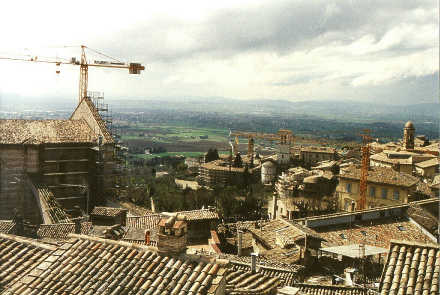Culture Shock: An Americans' Guide to Getting Around (and Getting Along) in Italy
 Timothy R. Adams
Timothy R. Adams
Accessibility
Although accessibility has improved since the early 80's, it appears to me that people in wheelchairs would have more difficulty getting around alone in Italy than in the US.
Most of the modern buildings seem to pose few accessibility obstacles. For example, the Vatican Museum and the cathedral museum in Florence have extensive ramp, elevator systems and accessible rest room facilities. However, many other buildings date back to renaissance, medieval and even earlier times, and are restricted to small scale renovations by statute and the laws of physics.
The convents we stayed at were mostly medieval. Even when they had elevators or stairway lifts, often there were also raised entrances with no ramps, or other accessibility barriers. Some convents and monasteries are modernizing and removing barriers as funding, donations, practicality and space allow. For example, as a result of devastating earthquake damage in the late 90's the St. Francis Guest House in Assisi was renovated and modernized, while protecting as much of the 14th century building as possible.
The older hotels we stayed at all had elevator service, but most often the elevators are 1/4 the size of their typical American counterparts.
Accessibility to transportation is much different from here. The Americans with Disabilities Act requires at least one car per consist be accessible. In Italy, wheelchair-accessible coaches with wide platform-level entrances are inconsistently included in inter-city and local consists. The on-board washrooms are often not accessible. The large timetables posted on the station walls list the accessibility symbol next to some trains indicating accessibility, suggesting that the others are not. The majority of the buses and streetcars lack wheelchair lifts.
Accessibility is also an issue in terms of getting to the train. There is no problem at the major terminals in Milan, Rome, Florence, Venice, and Naples. But at the major outlying regional hubs, six to eight sets of tracks lay parallel to the station, accessed by stairs leading to underground passages. This means that boarding a train at the track immediately next to the station would be no problem, but reaching the other tracks would be another matter. At some stations, there is elevator assistance available. At other stations, I couldn’t figure out how mobility-limited passengers would meet the train without significant help of others.
Venice, being a pedestrian-only city can present problems for persons with limited mobility to get around. They use technology to make it easier. Several steep pedestrian bridges have chair-lifts installed to help mobility-limited persons get across. Instead of carrying the passenger up stairs, the track curves over the bridge. Although no instructions were posted, it looked like anyone was allowed to operate it as needed.
The vaparetto in Venice is not easy for persons in wheelchairs. We saw a passenger in a wheelchair lifted on the boat by companions at one stop and lifted off at another. There was no ramp or bridgeplate to cover the gap between the dock and the boat, and the water was quite choppy.
Finally, plumbing is often an adventure for travelers; this applies to travelers with disabilities as well. The majority of the rest rooms on older buildings that I visited in Italy were barely accessible to people without disabilities, much less up to ADA standards. Doors are often narrow; facilities are often small. Many lack one or more of the features that Americans often take for granted: seat, paper, light, soap and hot (or any) water. It’s hard to figure where the light switch is, if there is a light. Another part of the adventure is determining how the blasted thing flushes. Some use a pull cord, electric switch in wall, or other strange methods to accomplishing what we take for granted. One time, when we couldn’t figure out any possible method of making the toilet flush, I suggesting closing the stall door (that did it!).
Many buildings were originally constructed long before indoor plumbing was considered “quality of life.” Most bath and toilet fixtures were added many years after the original construction in whatever space was available, i.e., closets, stairwells, attics, basements or storage areas. Some showers in older hotels and convents are not in a bathtub or separate shower stall, but consist of a wall-mounted spray head with a drain in the center of the room. This can be very messy.
Many railroad stations, although relatively modern (50-100 years), often have antiquated facilities sometimes consisting of a simple porcelain “hole-in-the-ground” with foot rests. This style of plumbing presents an unnerving means to experience a different culture, not to mention challenges (especially for women) that I don’t wish to go into. These are not just in the outlying points; there are several in Milan’s Statione Centrale.

Even several years after the earthquake, recovery and reconstruction
continued in
For other observations, please click on the link:
More photos are displayed at http://timothyadams_1.tripod.com.